ACCT19083 Corporate Governance & Ethics: Grameen Bank Case Study
VerifiedAdded on 2023/06/15
|22
|5681
|296
Report
AI Summary
This assignment provides answers to questions related to social responsibility and ethics, particularly in the context of corporate governance. It defines a socially responsible business with examples like Motorola and The Body Shop, and evaluates Grameen Bank as a socially responsible enterprise, highlighting its microcredit programs and impact on poverty reduction. Additionally, the assignment explains the concept of an ethical dilemma, providing hypothetical and management-related examples to illustrate the complexities involved in making ethically sound decisions. The assignment draws on academic sources to support its explanations and analysis.
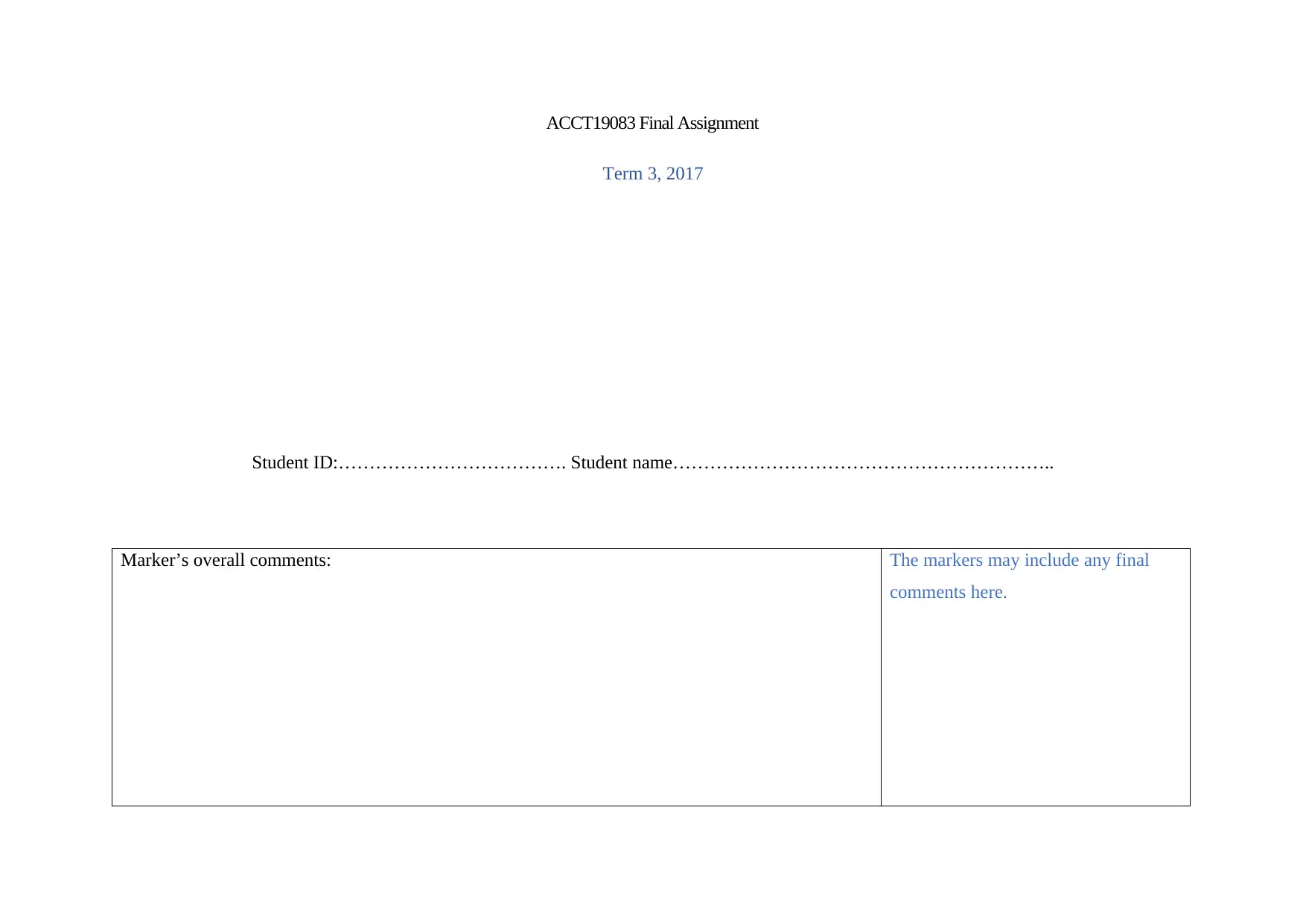
ACCT19083 Final Assignment
Term 3, 2017
Student ID:………………………………. Student name……………………………………………………..
Marker’s overall comments: The markers may include any final
comments here.
Term 3, 2017
Student ID:………………………………. Student name……………………………………………………..
Marker’s overall comments: The markers may include any final
comments here.
Paraphrase This Document
Need a fresh take? Get an instant paraphrase of this document with our AI Paraphraser
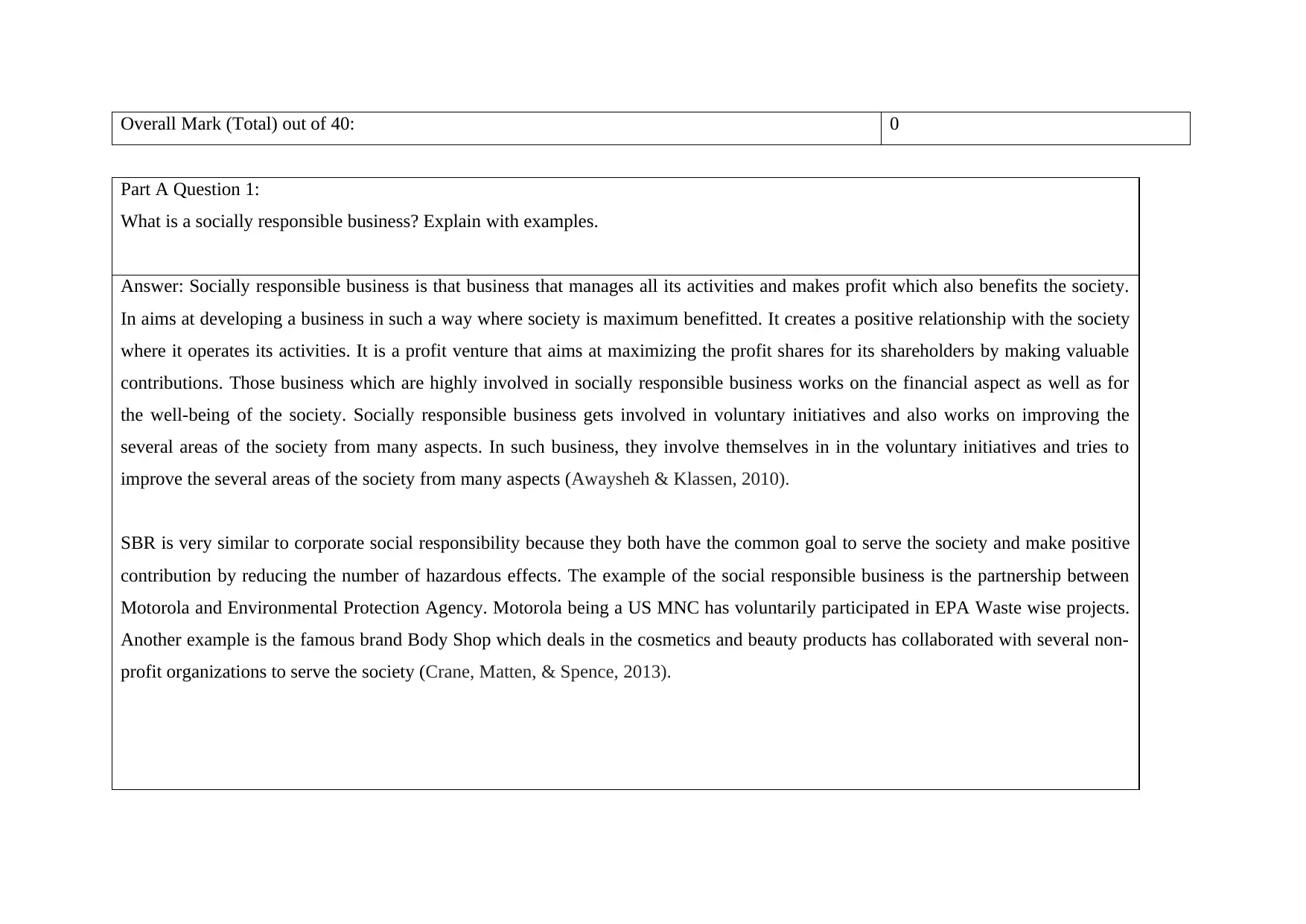
Overall Mark (Total) out of 40: 0
Part A Question 1:
What is a socially responsible business? Explain with examples.
Answer: Socially responsible business is that business that manages all its activities and makes profit which also benefits the society.
In aims at developing a business in such a way where society is maximum benefitted. It creates a positive relationship with the society
where it operates its activities. It is a profit venture that aims at maximizing the profit shares for its shareholders by making valuable
contributions. Those business which are highly involved in socially responsible business works on the financial aspect as well as for
the well-being of the society. Socially responsible business gets involved in voluntary initiatives and also works on improving the
several areas of the society from many aspects. In such business, they involve themselves in in the voluntary initiatives and tries to
improve the several areas of the society from many aspects (Awaysheh & Klassen, 2010).
SBR is very similar to corporate social responsibility because they both have the common goal to serve the society and make positive
contribution by reducing the number of hazardous effects. The example of the social responsible business is the partnership between
Motorola and Environmental Protection Agency. Motorola being a US MNC has voluntarily participated in EPA Waste wise projects.
Another example is the famous brand Body Shop which deals in the cosmetics and beauty products has collaborated with several non-
profit organizations to serve the society (Crane, Matten, & Spence, 2013).
Part A Question 1:
What is a socially responsible business? Explain with examples.
Answer: Socially responsible business is that business that manages all its activities and makes profit which also benefits the society.
In aims at developing a business in such a way where society is maximum benefitted. It creates a positive relationship with the society
where it operates its activities. It is a profit venture that aims at maximizing the profit shares for its shareholders by making valuable
contributions. Those business which are highly involved in socially responsible business works on the financial aspect as well as for
the well-being of the society. Socially responsible business gets involved in voluntary initiatives and also works on improving the
several areas of the society from many aspects. In such business, they involve themselves in in the voluntary initiatives and tries to
improve the several areas of the society from many aspects (Awaysheh & Klassen, 2010).
SBR is very similar to corporate social responsibility because they both have the common goal to serve the society and make positive
contribution by reducing the number of hazardous effects. The example of the social responsible business is the partnership between
Motorola and Environmental Protection Agency. Motorola being a US MNC has voluntarily participated in EPA Waste wise projects.
Another example is the famous brand Body Shop which deals in the cosmetics and beauty products has collaborated with several non-
profit organizations to serve the society (Crane, Matten, & Spence, 2013).
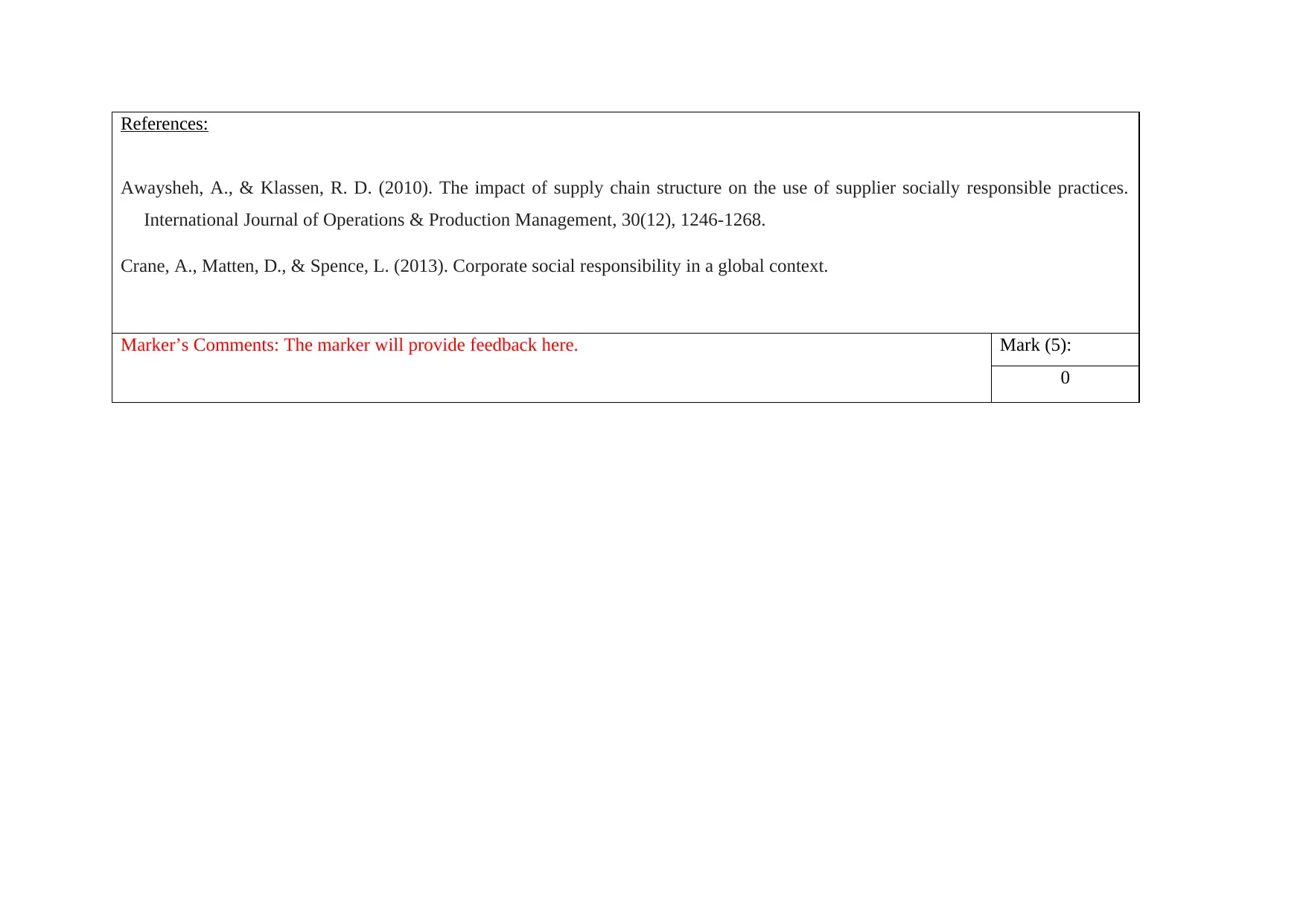
References:
Awaysheh, A., & Klassen, R. D. (2010). The impact of supply chain structure on the use of supplier socially responsible practices.
International Journal of Operations & Production Management, 30(12), 1246-1268.
Crane, A., Matten, D., & Spence, L. (2013). Corporate social responsibility in a global context.
Marker’s Comments: The marker will provide feedback here. Mark (5):
0
Awaysheh, A., & Klassen, R. D. (2010). The impact of supply chain structure on the use of supplier socially responsible practices.
International Journal of Operations & Production Management, 30(12), 1246-1268.
Crane, A., Matten, D., & Spence, L. (2013). Corporate social responsibility in a global context.
Marker’s Comments: The marker will provide feedback here. Mark (5):
0
⊘ This is a preview!⊘
Do you want full access?
Subscribe today to unlock all pages.

Trusted by 1+ million students worldwide
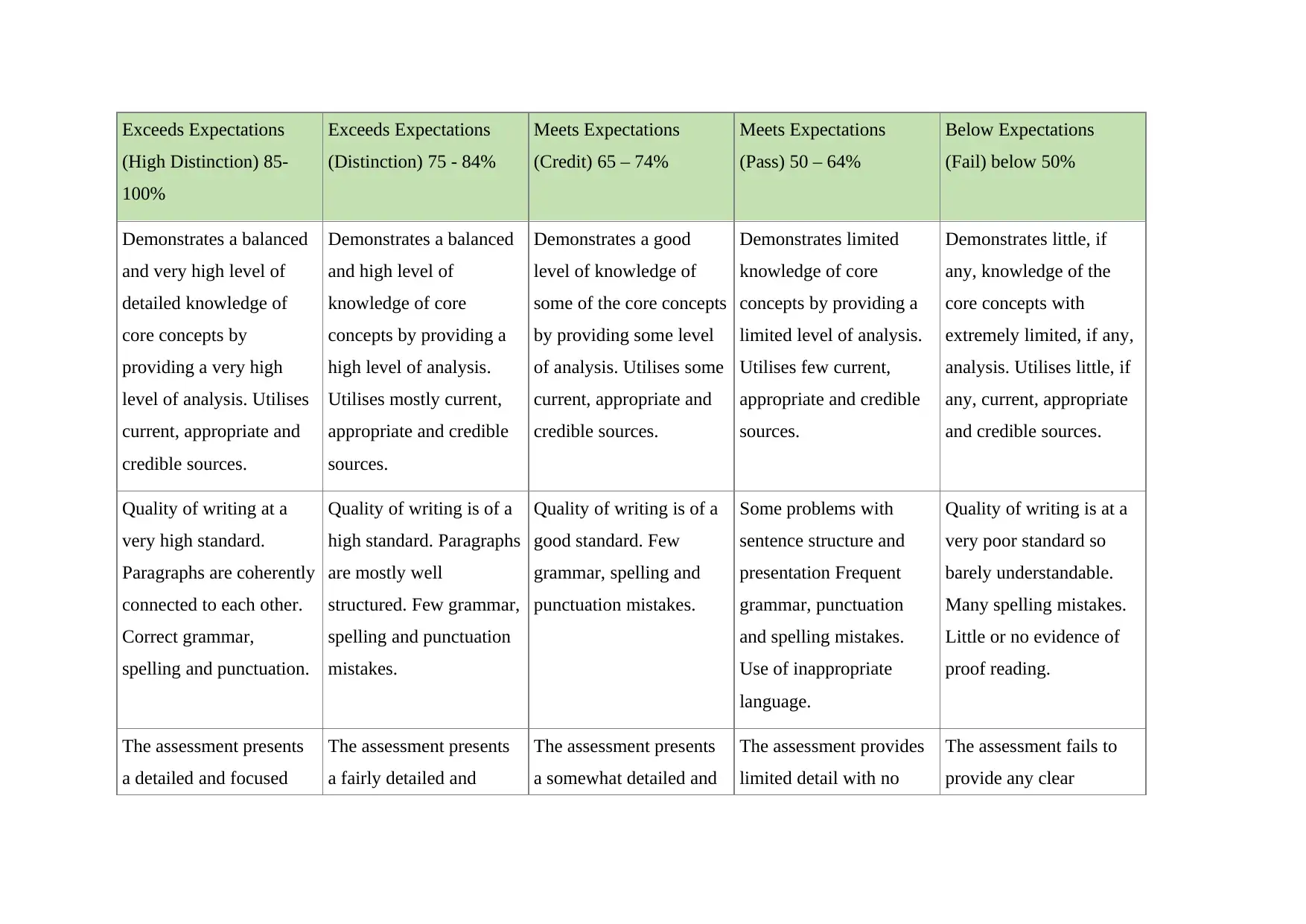
Exceeds Expectations
(High Distinction) 85-
100%
Exceeds Expectations
(Distinction) 75 - 84%
Meets Expectations
(Credit) 65 – 74%
Meets Expectations
(Pass) 50 – 64%
Below Expectations
(Fail) below 50%
Demonstrates a balanced
and very high level of
detailed knowledge of
core concepts by
providing a very high
level of analysis. Utilises
current, appropriate and
credible sources.
Demonstrates a balanced
and high level of
knowledge of core
concepts by providing a
high level of analysis.
Utilises mostly current,
appropriate and credible
sources.
Demonstrates a good
level of knowledge of
some of the core concepts
by providing some level
of analysis. Utilises some
current, appropriate and
credible sources.
Demonstrates limited
knowledge of core
concepts by providing a
limited level of analysis.
Utilises few current,
appropriate and credible
sources.
Demonstrates little, if
any, knowledge of the
core concepts with
extremely limited, if any,
analysis. Utilises little, if
any, current, appropriate
and credible sources.
Quality of writing at a
very high standard.
Paragraphs are coherently
connected to each other.
Correct grammar,
spelling and punctuation.
Quality of writing is of a
high standard. Paragraphs
are mostly well
structured. Few grammar,
spelling and punctuation
mistakes.
Quality of writing is of a
good standard. Few
grammar, spelling and
punctuation mistakes.
Some problems with
sentence structure and
presentation Frequent
grammar, punctuation
and spelling mistakes.
Use of inappropriate
language.
Quality of writing is at a
very poor standard so
barely understandable.
Many spelling mistakes.
Little or no evidence of
proof reading.
The assessment presents
a detailed and focused
The assessment presents
a fairly detailed and
The assessment presents
a somewhat detailed and
The assessment provides
limited detail with no
The assessment fails to
provide any clear
(High Distinction) 85-
100%
Exceeds Expectations
(Distinction) 75 - 84%
Meets Expectations
(Credit) 65 – 74%
Meets Expectations
(Pass) 50 – 64%
Below Expectations
(Fail) below 50%
Demonstrates a balanced
and very high level of
detailed knowledge of
core concepts by
providing a very high
level of analysis. Utilises
current, appropriate and
credible sources.
Demonstrates a balanced
and high level of
knowledge of core
concepts by providing a
high level of analysis.
Utilises mostly current,
appropriate and credible
sources.
Demonstrates a good
level of knowledge of
some of the core concepts
by providing some level
of analysis. Utilises some
current, appropriate and
credible sources.
Demonstrates limited
knowledge of core
concepts by providing a
limited level of analysis.
Utilises few current,
appropriate and credible
sources.
Demonstrates little, if
any, knowledge of the
core concepts with
extremely limited, if any,
analysis. Utilises little, if
any, current, appropriate
and credible sources.
Quality of writing at a
very high standard.
Paragraphs are coherently
connected to each other.
Correct grammar,
spelling and punctuation.
Quality of writing is of a
high standard. Paragraphs
are mostly well
structured. Few grammar,
spelling and punctuation
mistakes.
Quality of writing is of a
good standard. Few
grammar, spelling and
punctuation mistakes.
Some problems with
sentence structure and
presentation Frequent
grammar, punctuation
and spelling mistakes.
Use of inappropriate
language.
Quality of writing is at a
very poor standard so
barely understandable.
Many spelling mistakes.
Little or no evidence of
proof reading.
The assessment presents
a detailed and focused
The assessment presents
a fairly detailed and
The assessment presents
a somewhat detailed and
The assessment provides
limited detail with no
The assessment fails to
provide any clear
Paraphrase This Document
Need a fresh take? Get an instant paraphrase of this document with our AI Paraphraser
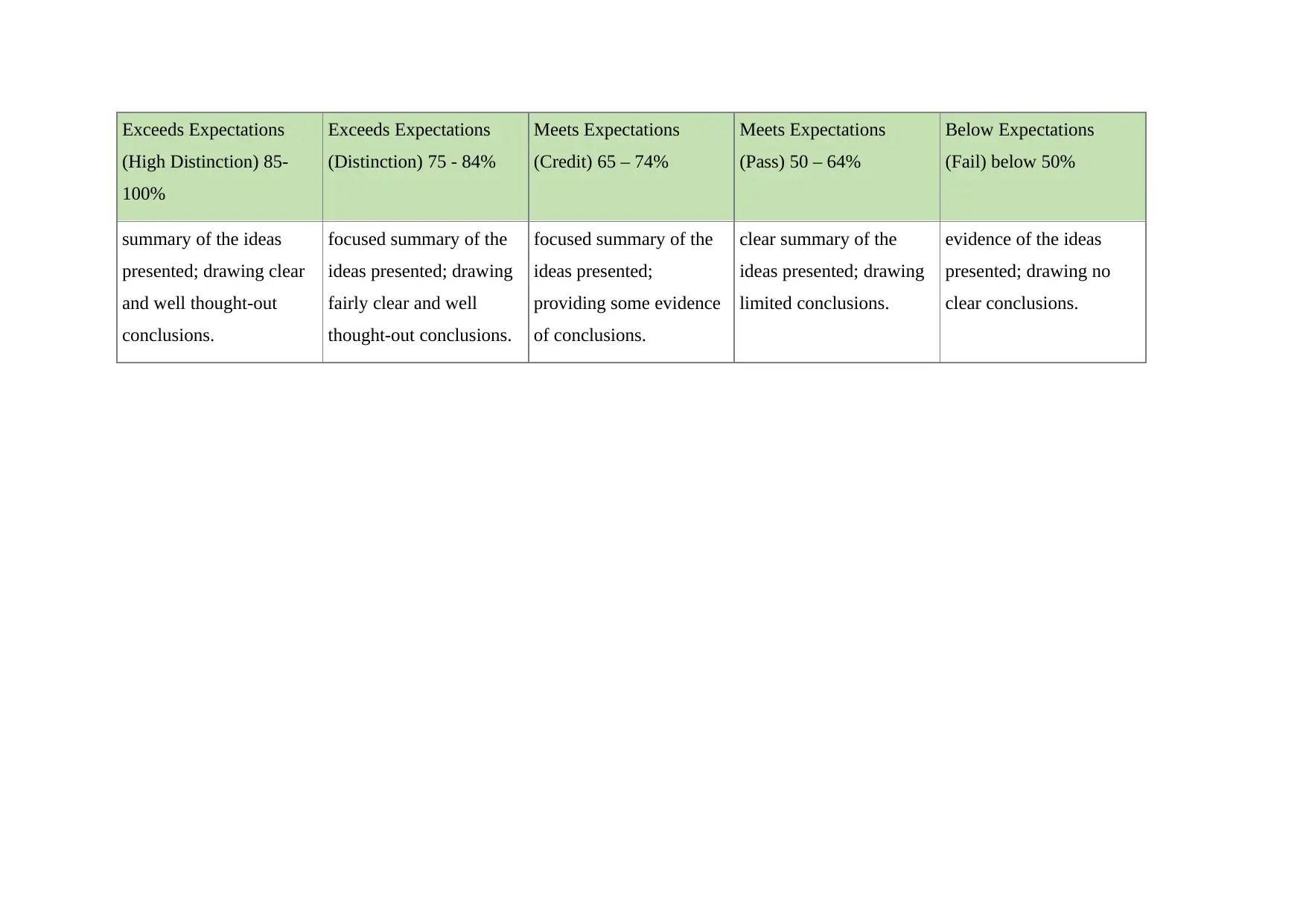
Exceeds Expectations
(High Distinction) 85-
100%
Exceeds Expectations
(Distinction) 75 - 84%
Meets Expectations
(Credit) 65 – 74%
Meets Expectations
(Pass) 50 – 64%
Below Expectations
(Fail) below 50%
summary of the ideas
presented; drawing clear
and well thought-out
conclusions.
focused summary of the
ideas presented; drawing
fairly clear and well
thought-out conclusions.
focused summary of the
ideas presented;
providing some evidence
of conclusions.
clear summary of the
ideas presented; drawing
limited conclusions.
evidence of the ideas
presented; drawing no
clear conclusions.
(High Distinction) 85-
100%
Exceeds Expectations
(Distinction) 75 - 84%
Meets Expectations
(Credit) 65 – 74%
Meets Expectations
(Pass) 50 – 64%
Below Expectations
(Fail) below 50%
summary of the ideas
presented; drawing clear
and well thought-out
conclusions.
focused summary of the
ideas presented; drawing
fairly clear and well
thought-out conclusions.
focused summary of the
ideas presented;
providing some evidence
of conclusions.
clear summary of the
ideas presented; drawing
limited conclusions.
evidence of the ideas
presented; drawing no
clear conclusions.
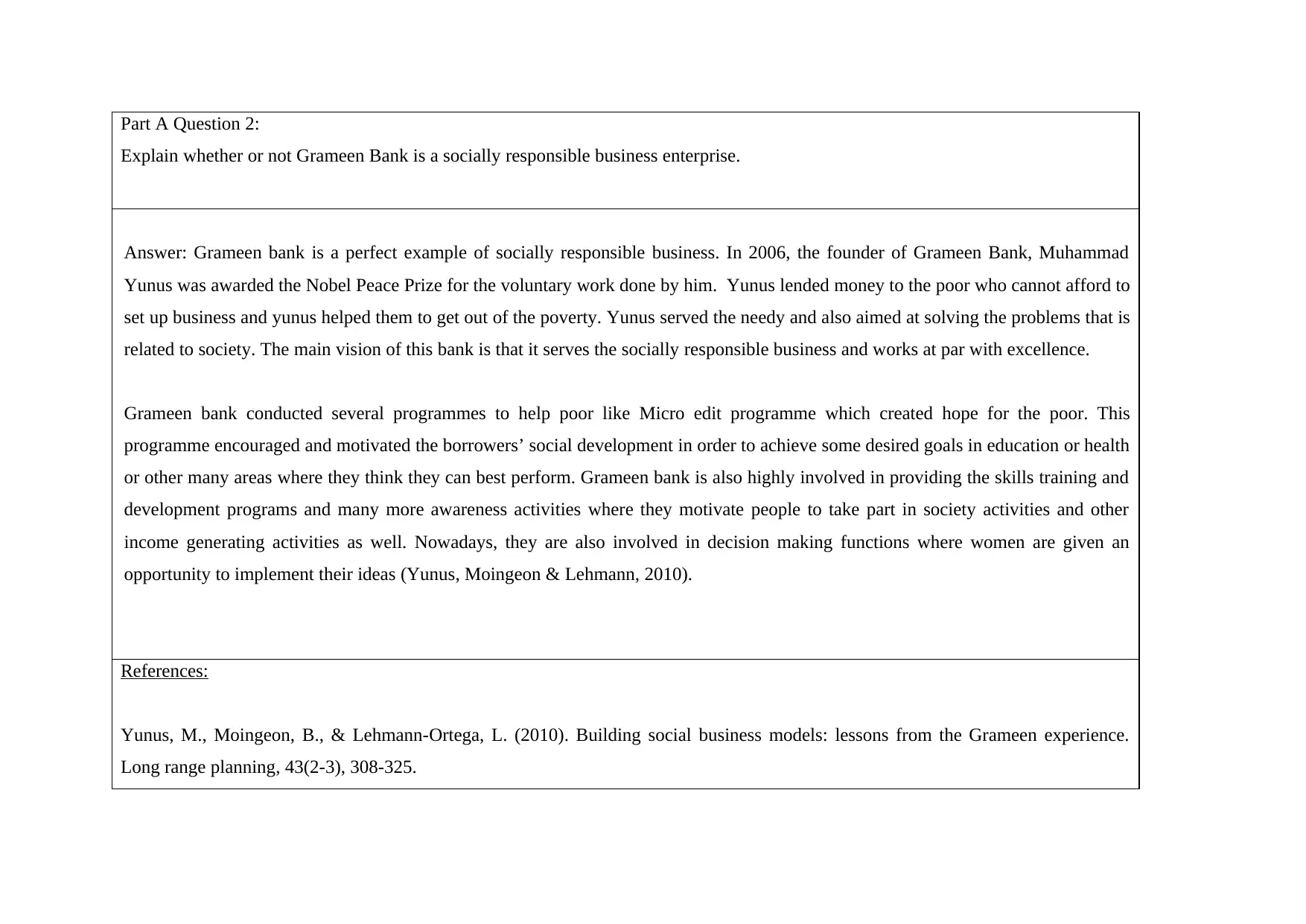
Part A Question 2:
Explain whether or not Grameen Bank is a socially responsible business enterprise.
Answer: Grameen bank is a perfect example of socially responsible business. In 2006, the founder of Grameen Bank, Muhammad
Yunus was awarded the Nobel Peace Prize for the voluntary work done by him. Yunus lended money to the poor who cannot afford to
set up business and yunus helped them to get out of the poverty. Yunus served the needy and also aimed at solving the problems that is
related to society. The main vision of this bank is that it serves the socially responsible business and works at par with excellence.
Grameen bank conducted several programmes to help poor like Micro edit programme which created hope for the poor. This
programme encouraged and motivated the borrowers’ social development in order to achieve some desired goals in education or health
or other many areas where they think they can best perform. Grameen bank is also highly involved in providing the skills training and
development programs and many more awareness activities where they motivate people to take part in society activities and other
income generating activities as well. Nowadays, they are also involved in decision making functions where women are given an
opportunity to implement their ideas (Yunus, Moingeon & Lehmann, 2010).
References:
Yunus, M., Moingeon, B., & Lehmann-Ortega, L. (2010). Building social business models: lessons from the Grameen experience.
Long range planning, 43(2-3), 308-325.
Explain whether or not Grameen Bank is a socially responsible business enterprise.
Answer: Grameen bank is a perfect example of socially responsible business. In 2006, the founder of Grameen Bank, Muhammad
Yunus was awarded the Nobel Peace Prize for the voluntary work done by him. Yunus lended money to the poor who cannot afford to
set up business and yunus helped them to get out of the poverty. Yunus served the needy and also aimed at solving the problems that is
related to society. The main vision of this bank is that it serves the socially responsible business and works at par with excellence.
Grameen bank conducted several programmes to help poor like Micro edit programme which created hope for the poor. This
programme encouraged and motivated the borrowers’ social development in order to achieve some desired goals in education or health
or other many areas where they think they can best perform. Grameen bank is also highly involved in providing the skills training and
development programs and many more awareness activities where they motivate people to take part in society activities and other
income generating activities as well. Nowadays, they are also involved in decision making functions where women are given an
opportunity to implement their ideas (Yunus, Moingeon & Lehmann, 2010).
References:
Yunus, M., Moingeon, B., & Lehmann-Ortega, L. (2010). Building social business models: lessons from the Grameen experience.
Long range planning, 43(2-3), 308-325.
⊘ This is a preview!⊘
Do you want full access?
Subscribe today to unlock all pages.

Trusted by 1+ million students worldwide
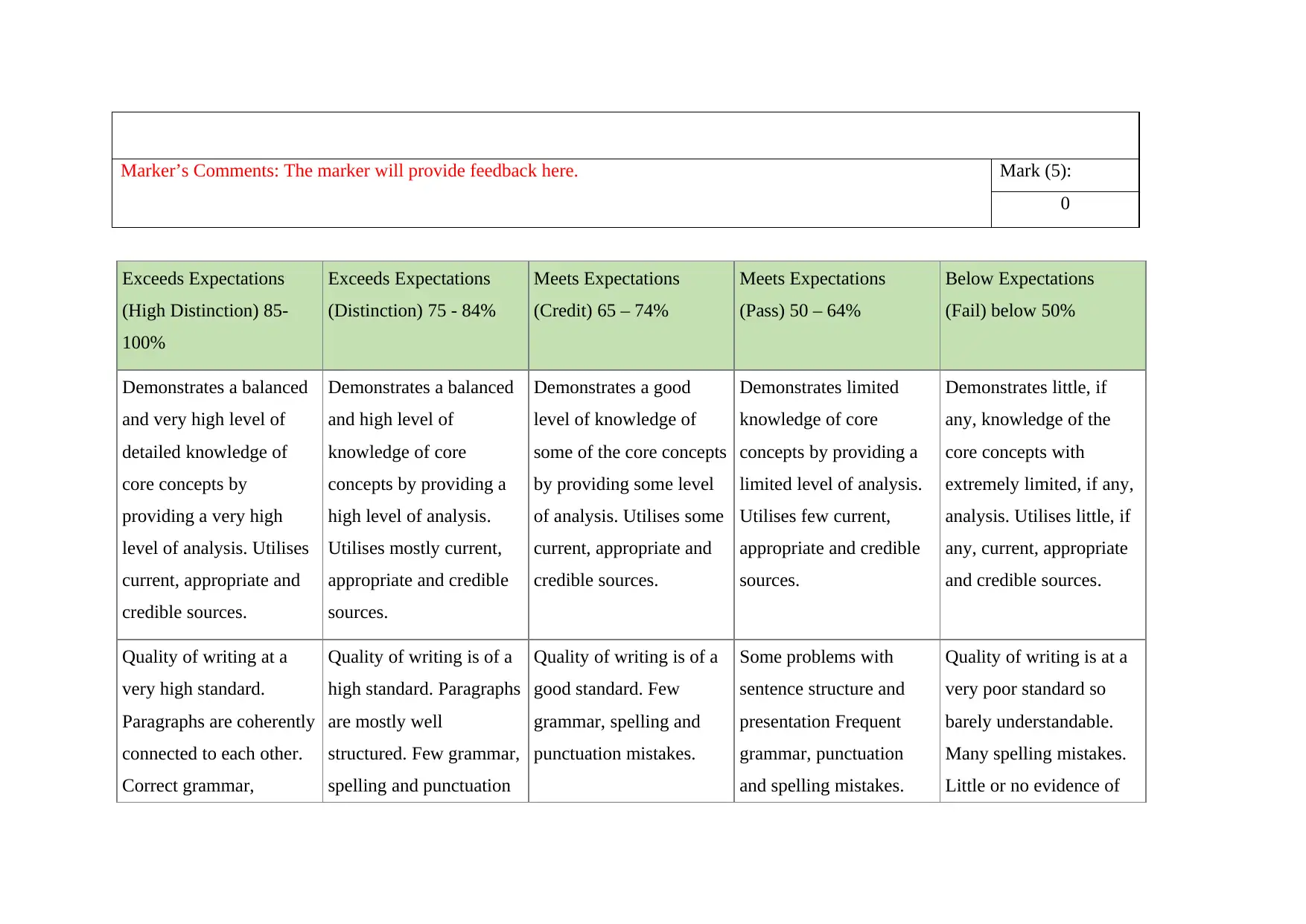
Marker’s Comments: The marker will provide feedback here. Mark (5):
0
Exceeds Expectations
(High Distinction) 85-
100%
Exceeds Expectations
(Distinction) 75 - 84%
Meets Expectations
(Credit) 65 – 74%
Meets Expectations
(Pass) 50 – 64%
Below Expectations
(Fail) below 50%
Demonstrates a balanced
and very high level of
detailed knowledge of
core concepts by
providing a very high
level of analysis. Utilises
current, appropriate and
credible sources.
Demonstrates a balanced
and high level of
knowledge of core
concepts by providing a
high level of analysis.
Utilises mostly current,
appropriate and credible
sources.
Demonstrates a good
level of knowledge of
some of the core concepts
by providing some level
of analysis. Utilises some
current, appropriate and
credible sources.
Demonstrates limited
knowledge of core
concepts by providing a
limited level of analysis.
Utilises few current,
appropriate and credible
sources.
Demonstrates little, if
any, knowledge of the
core concepts with
extremely limited, if any,
analysis. Utilises little, if
any, current, appropriate
and credible sources.
Quality of writing at a
very high standard.
Paragraphs are coherently
connected to each other.
Correct grammar,
Quality of writing is of a
high standard. Paragraphs
are mostly well
structured. Few grammar,
spelling and punctuation
Quality of writing is of a
good standard. Few
grammar, spelling and
punctuation mistakes.
Some problems with
sentence structure and
presentation Frequent
grammar, punctuation
and spelling mistakes.
Quality of writing is at a
very poor standard so
barely understandable.
Many spelling mistakes.
Little or no evidence of
0
Exceeds Expectations
(High Distinction) 85-
100%
Exceeds Expectations
(Distinction) 75 - 84%
Meets Expectations
(Credit) 65 – 74%
Meets Expectations
(Pass) 50 – 64%
Below Expectations
(Fail) below 50%
Demonstrates a balanced
and very high level of
detailed knowledge of
core concepts by
providing a very high
level of analysis. Utilises
current, appropriate and
credible sources.
Demonstrates a balanced
and high level of
knowledge of core
concepts by providing a
high level of analysis.
Utilises mostly current,
appropriate and credible
sources.
Demonstrates a good
level of knowledge of
some of the core concepts
by providing some level
of analysis. Utilises some
current, appropriate and
credible sources.
Demonstrates limited
knowledge of core
concepts by providing a
limited level of analysis.
Utilises few current,
appropriate and credible
sources.
Demonstrates little, if
any, knowledge of the
core concepts with
extremely limited, if any,
analysis. Utilises little, if
any, current, appropriate
and credible sources.
Quality of writing at a
very high standard.
Paragraphs are coherently
connected to each other.
Correct grammar,
Quality of writing is of a
high standard. Paragraphs
are mostly well
structured. Few grammar,
spelling and punctuation
Quality of writing is of a
good standard. Few
grammar, spelling and
punctuation mistakes.
Some problems with
sentence structure and
presentation Frequent
grammar, punctuation
and spelling mistakes.
Quality of writing is at a
very poor standard so
barely understandable.
Many spelling mistakes.
Little or no evidence of
Paraphrase This Document
Need a fresh take? Get an instant paraphrase of this document with our AI Paraphraser
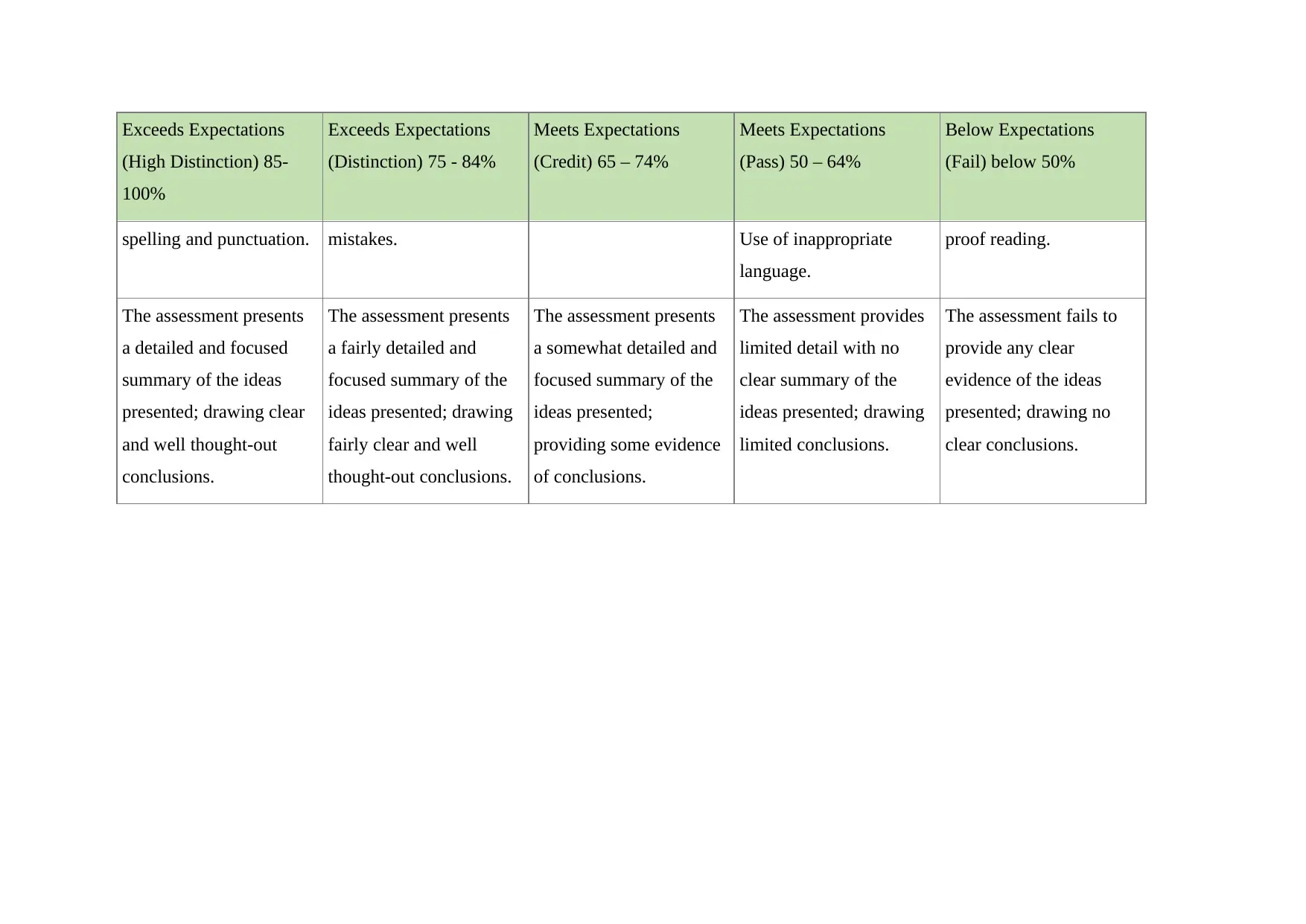
Exceeds Expectations
(High Distinction) 85-
100%
Exceeds Expectations
(Distinction) 75 - 84%
Meets Expectations
(Credit) 65 – 74%
Meets Expectations
(Pass) 50 – 64%
Below Expectations
(Fail) below 50%
spelling and punctuation. mistakes. Use of inappropriate
language.
proof reading.
The assessment presents
a detailed and focused
summary of the ideas
presented; drawing clear
and well thought-out
conclusions.
The assessment presents
a fairly detailed and
focused summary of the
ideas presented; drawing
fairly clear and well
thought-out conclusions.
The assessment presents
a somewhat detailed and
focused summary of the
ideas presented;
providing some evidence
of conclusions.
The assessment provides
limited detail with no
clear summary of the
ideas presented; drawing
limited conclusions.
The assessment fails to
provide any clear
evidence of the ideas
presented; drawing no
clear conclusions.
(High Distinction) 85-
100%
Exceeds Expectations
(Distinction) 75 - 84%
Meets Expectations
(Credit) 65 – 74%
Meets Expectations
(Pass) 50 – 64%
Below Expectations
(Fail) below 50%
spelling and punctuation. mistakes. Use of inappropriate
language.
proof reading.
The assessment presents
a detailed and focused
summary of the ideas
presented; drawing clear
and well thought-out
conclusions.
The assessment presents
a fairly detailed and
focused summary of the
ideas presented; drawing
fairly clear and well
thought-out conclusions.
The assessment presents
a somewhat detailed and
focused summary of the
ideas presented;
providing some evidence
of conclusions.
The assessment provides
limited detail with no
clear summary of the
ideas presented; drawing
limited conclusions.
The assessment fails to
provide any clear
evidence of the ideas
presented; drawing no
clear conclusions.
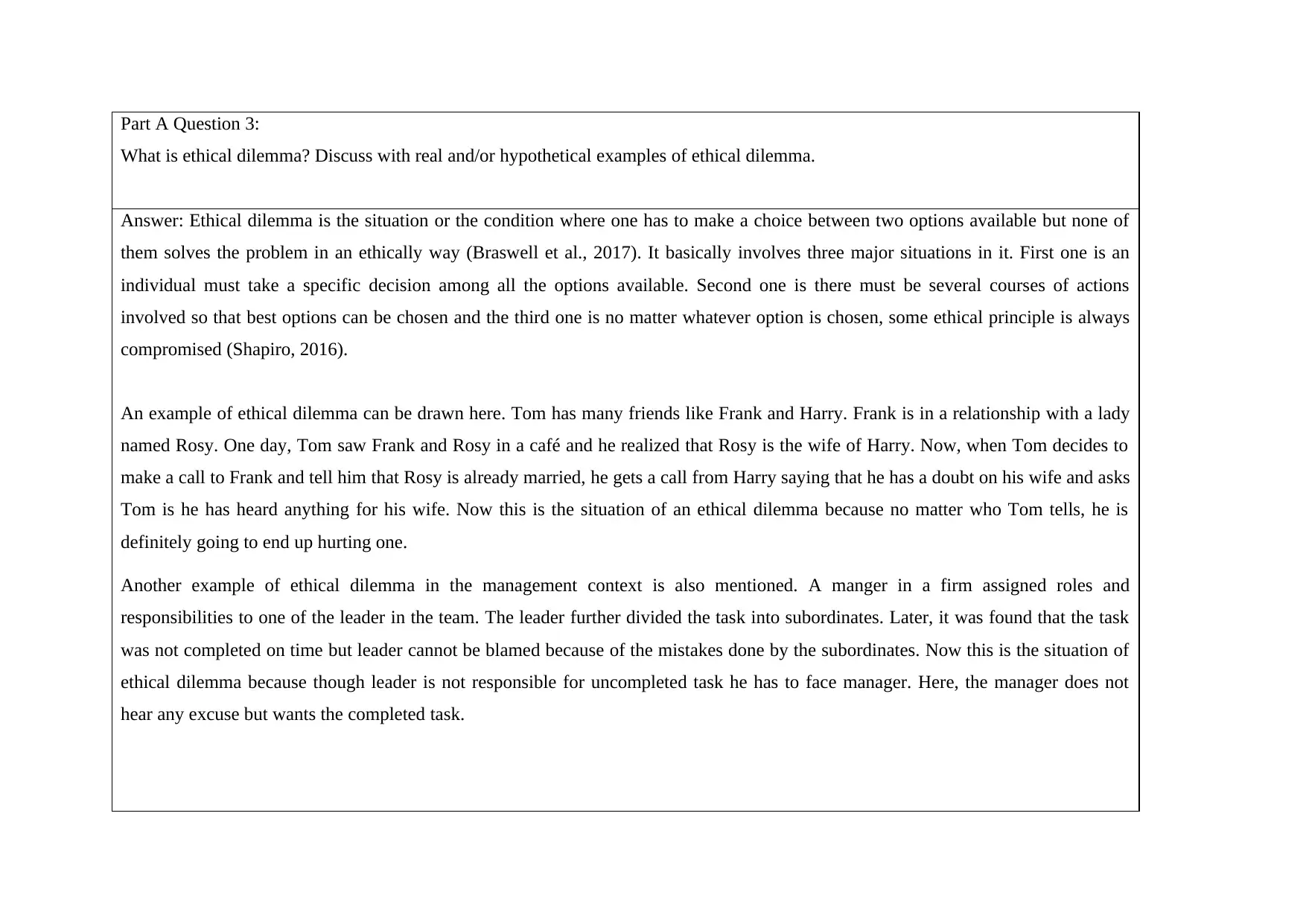
Part A Question 3:
What is ethical dilemma? Discuss with real and/or hypothetical examples of ethical dilemma.
Answer: Ethical dilemma is the situation or the condition where one has to make a choice between two options available but none of
them solves the problem in an ethically way (Braswell et al., 2017). It basically involves three major situations in it. First one is an
individual must take a specific decision among all the options available. Second one is there must be several courses of actions
involved so that best options can be chosen and the third one is no matter whatever option is chosen, some ethical principle is always
compromised (Shapiro, 2016).
An example of ethical dilemma can be drawn here. Tom has many friends like Frank and Harry. Frank is in a relationship with a lady
named Rosy. One day, Tom saw Frank and Rosy in a café and he realized that Rosy is the wife of Harry. Now, when Tom decides to
make a call to Frank and tell him that Rosy is already married, he gets a call from Harry saying that he has a doubt on his wife and asks
Tom is he has heard anything for his wife. Now this is the situation of an ethical dilemma because no matter who Tom tells, he is
definitely going to end up hurting one.
Another example of ethical dilemma in the management context is also mentioned. A manger in a firm assigned roles and
responsibilities to one of the leader in the team. The leader further divided the task into subordinates. Later, it was found that the task
was not completed on time but leader cannot be blamed because of the mistakes done by the subordinates. Now this is the situation of
ethical dilemma because though leader is not responsible for uncompleted task he has to face manager. Here, the manager does not
hear any excuse but wants the completed task.
What is ethical dilemma? Discuss with real and/or hypothetical examples of ethical dilemma.
Answer: Ethical dilemma is the situation or the condition where one has to make a choice between two options available but none of
them solves the problem in an ethically way (Braswell et al., 2017). It basically involves three major situations in it. First one is an
individual must take a specific decision among all the options available. Second one is there must be several courses of actions
involved so that best options can be chosen and the third one is no matter whatever option is chosen, some ethical principle is always
compromised (Shapiro, 2016).
An example of ethical dilemma can be drawn here. Tom has many friends like Frank and Harry. Frank is in a relationship with a lady
named Rosy. One day, Tom saw Frank and Rosy in a café and he realized that Rosy is the wife of Harry. Now, when Tom decides to
make a call to Frank and tell him that Rosy is already married, he gets a call from Harry saying that he has a doubt on his wife and asks
Tom is he has heard anything for his wife. Now this is the situation of an ethical dilemma because no matter who Tom tells, he is
definitely going to end up hurting one.
Another example of ethical dilemma in the management context is also mentioned. A manger in a firm assigned roles and
responsibilities to one of the leader in the team. The leader further divided the task into subordinates. Later, it was found that the task
was not completed on time but leader cannot be blamed because of the mistakes done by the subordinates. Now this is the situation of
ethical dilemma because though leader is not responsible for uncompleted task he has to face manager. Here, the manager does not
hear any excuse but wants the completed task.
⊘ This is a preview!⊘
Do you want full access?
Subscribe today to unlock all pages.

Trusted by 1+ million students worldwide
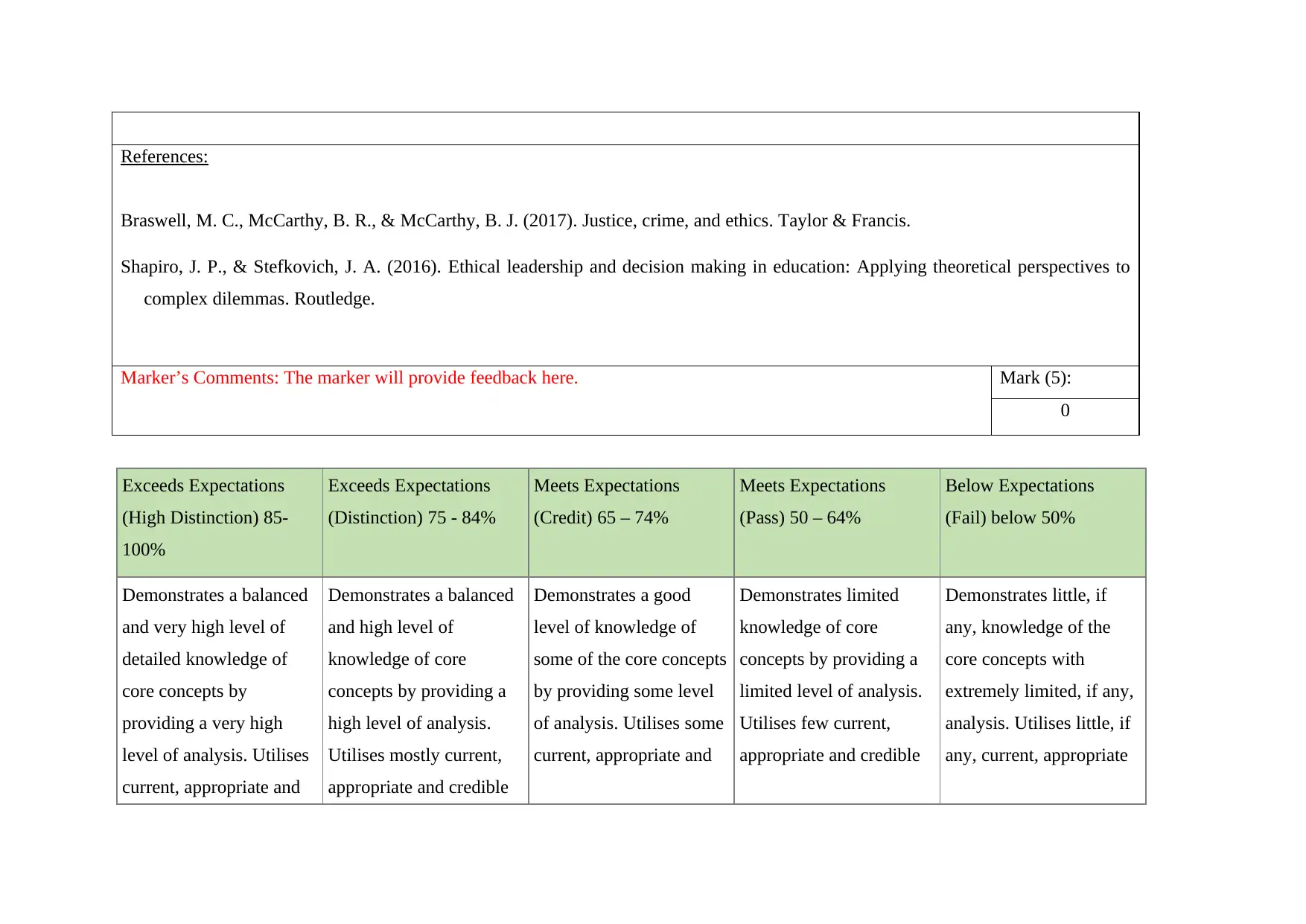
References:
Braswell, M. C., McCarthy, B. R., & McCarthy, B. J. (2017). Justice, crime, and ethics. Taylor & Francis.
Shapiro, J. P., & Stefkovich, J. A. (2016). Ethical leadership and decision making in education: Applying theoretical perspectives to
complex dilemmas. Routledge.
Marker’s Comments: The marker will provide feedback here. Mark (5):
0
Exceeds Expectations
(High Distinction) 85-
100%
Exceeds Expectations
(Distinction) 75 - 84%
Meets Expectations
(Credit) 65 – 74%
Meets Expectations
(Pass) 50 – 64%
Below Expectations
(Fail) below 50%
Demonstrates a balanced
and very high level of
detailed knowledge of
core concepts by
providing a very high
level of analysis. Utilises
current, appropriate and
Demonstrates a balanced
and high level of
knowledge of core
concepts by providing a
high level of analysis.
Utilises mostly current,
appropriate and credible
Demonstrates a good
level of knowledge of
some of the core concepts
by providing some level
of analysis. Utilises some
current, appropriate and
Demonstrates limited
knowledge of core
concepts by providing a
limited level of analysis.
Utilises few current,
appropriate and credible
Demonstrates little, if
any, knowledge of the
core concepts with
extremely limited, if any,
analysis. Utilises little, if
any, current, appropriate
Braswell, M. C., McCarthy, B. R., & McCarthy, B. J. (2017). Justice, crime, and ethics. Taylor & Francis.
Shapiro, J. P., & Stefkovich, J. A. (2016). Ethical leadership and decision making in education: Applying theoretical perspectives to
complex dilemmas. Routledge.
Marker’s Comments: The marker will provide feedback here. Mark (5):
0
Exceeds Expectations
(High Distinction) 85-
100%
Exceeds Expectations
(Distinction) 75 - 84%
Meets Expectations
(Credit) 65 – 74%
Meets Expectations
(Pass) 50 – 64%
Below Expectations
(Fail) below 50%
Demonstrates a balanced
and very high level of
detailed knowledge of
core concepts by
providing a very high
level of analysis. Utilises
current, appropriate and
Demonstrates a balanced
and high level of
knowledge of core
concepts by providing a
high level of analysis.
Utilises mostly current,
appropriate and credible
Demonstrates a good
level of knowledge of
some of the core concepts
by providing some level
of analysis. Utilises some
current, appropriate and
Demonstrates limited
knowledge of core
concepts by providing a
limited level of analysis.
Utilises few current,
appropriate and credible
Demonstrates little, if
any, knowledge of the
core concepts with
extremely limited, if any,
analysis. Utilises little, if
any, current, appropriate
Paraphrase This Document
Need a fresh take? Get an instant paraphrase of this document with our AI Paraphraser
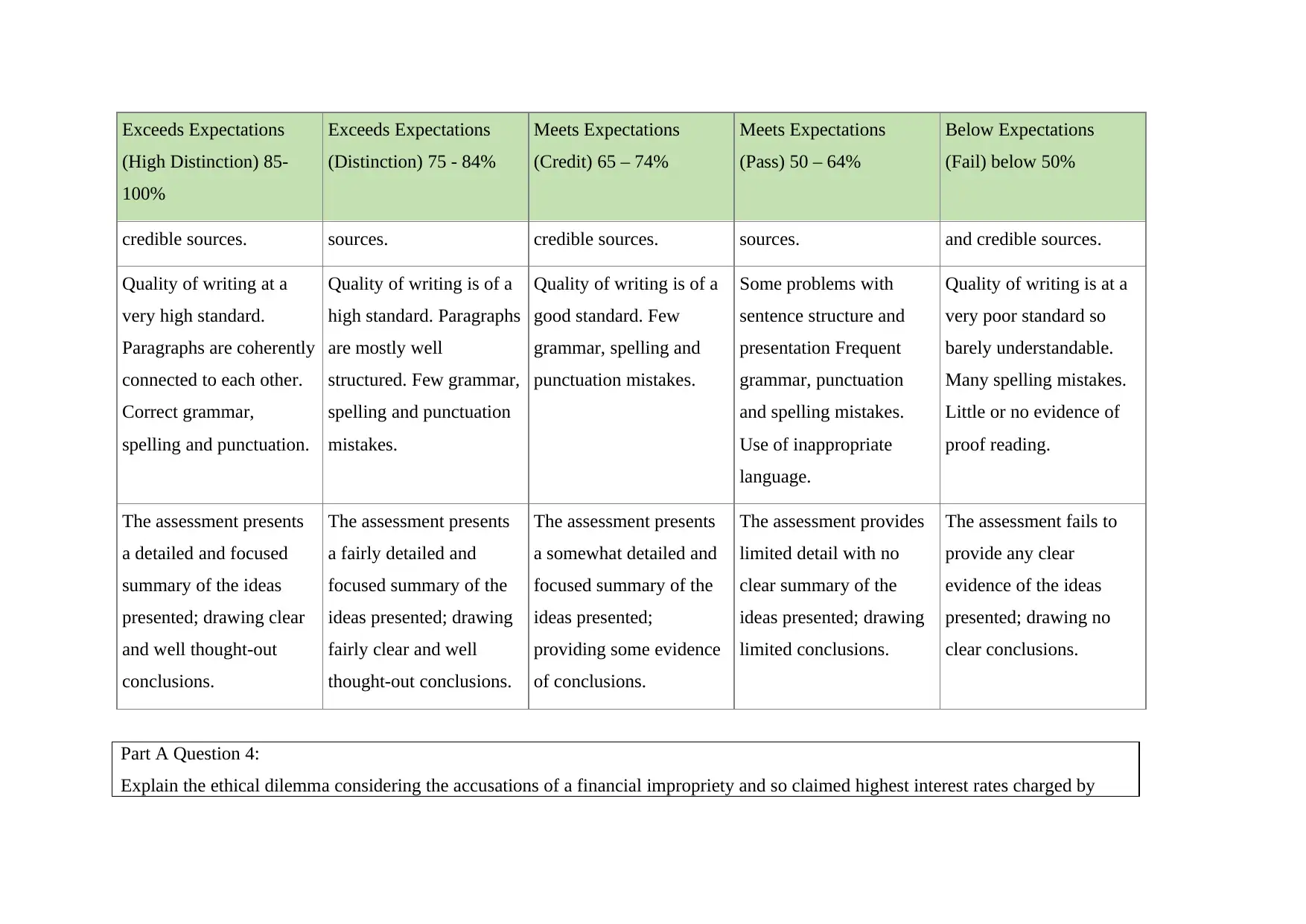
Exceeds Expectations
(High Distinction) 85-
100%
Exceeds Expectations
(Distinction) 75 - 84%
Meets Expectations
(Credit) 65 – 74%
Meets Expectations
(Pass) 50 – 64%
Below Expectations
(Fail) below 50%
credible sources. sources. credible sources. sources. and credible sources.
Quality of writing at a
very high standard.
Paragraphs are coherently
connected to each other.
Correct grammar,
spelling and punctuation.
Quality of writing is of a
high standard. Paragraphs
are mostly well
structured. Few grammar,
spelling and punctuation
mistakes.
Quality of writing is of a
good standard. Few
grammar, spelling and
punctuation mistakes.
Some problems with
sentence structure and
presentation Frequent
grammar, punctuation
and spelling mistakes.
Use of inappropriate
language.
Quality of writing is at a
very poor standard so
barely understandable.
Many spelling mistakes.
Little or no evidence of
proof reading.
The assessment presents
a detailed and focused
summary of the ideas
presented; drawing clear
and well thought-out
conclusions.
The assessment presents
a fairly detailed and
focused summary of the
ideas presented; drawing
fairly clear and well
thought-out conclusions.
The assessment presents
a somewhat detailed and
focused summary of the
ideas presented;
providing some evidence
of conclusions.
The assessment provides
limited detail with no
clear summary of the
ideas presented; drawing
limited conclusions.
The assessment fails to
provide any clear
evidence of the ideas
presented; drawing no
clear conclusions.
Part A Question 4:
Explain the ethical dilemma considering the accusations of a financial impropriety and so claimed highest interest rates charged by
(High Distinction) 85-
100%
Exceeds Expectations
(Distinction) 75 - 84%
Meets Expectations
(Credit) 65 – 74%
Meets Expectations
(Pass) 50 – 64%
Below Expectations
(Fail) below 50%
credible sources. sources. credible sources. sources. and credible sources.
Quality of writing at a
very high standard.
Paragraphs are coherently
connected to each other.
Correct grammar,
spelling and punctuation.
Quality of writing is of a
high standard. Paragraphs
are mostly well
structured. Few grammar,
spelling and punctuation
mistakes.
Quality of writing is of a
good standard. Few
grammar, spelling and
punctuation mistakes.
Some problems with
sentence structure and
presentation Frequent
grammar, punctuation
and spelling mistakes.
Use of inappropriate
language.
Quality of writing is at a
very poor standard so
barely understandable.
Many spelling mistakes.
Little or no evidence of
proof reading.
The assessment presents
a detailed and focused
summary of the ideas
presented; drawing clear
and well thought-out
conclusions.
The assessment presents
a fairly detailed and
focused summary of the
ideas presented; drawing
fairly clear and well
thought-out conclusions.
The assessment presents
a somewhat detailed and
focused summary of the
ideas presented;
providing some evidence
of conclusions.
The assessment provides
limited detail with no
clear summary of the
ideas presented; drawing
limited conclusions.
The assessment fails to
provide any clear
evidence of the ideas
presented; drawing no
clear conclusions.
Part A Question 4:
Explain the ethical dilemma considering the accusations of a financial impropriety and so claimed highest interest rates charged by
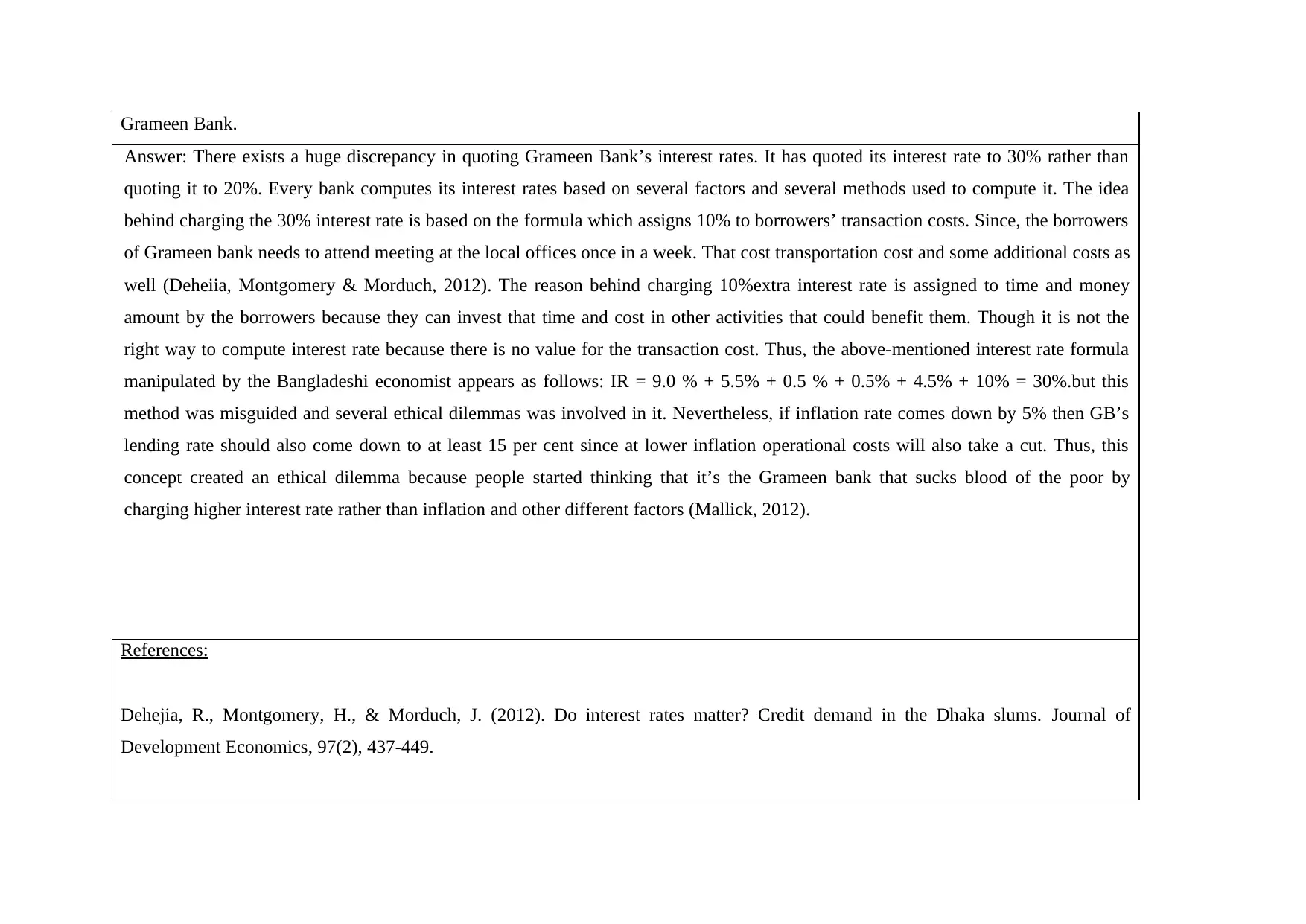
Grameen Bank.
Answer: There exists a huge discrepancy in quoting Grameen Bank’s interest rates. It has quoted its interest rate to 30% rather than
quoting it to 20%. Every bank computes its interest rates based on several factors and several methods used to compute it. The idea
behind charging the 30% interest rate is based on the formula which assigns 10% to borrowers’ transaction costs. Since, the borrowers
of Grameen bank needs to attend meeting at the local offices once in a week. That cost transportation cost and some additional costs as
well (Deheiia, Montgomery & Morduch, 2012). The reason behind charging 10%extra interest rate is assigned to time and money
amount by the borrowers because they can invest that time and cost in other activities that could benefit them. Though it is not the
right way to compute interest rate because there is no value for the transaction cost. Thus, the above-mentioned interest rate formula
manipulated by the Bangladeshi economist appears as follows: IR = 9.0 % + 5.5% + 0.5 % + 0.5% + 4.5% + 10% = 30%.but this
method was misguided and several ethical dilemmas was involved in it. Nevertheless, if inflation rate comes down by 5% then GB’s
lending rate should also come down to at least 15 per cent since at lower inflation operational costs will also take a cut. Thus, this
concept created an ethical dilemma because people started thinking that it’s the Grameen bank that sucks blood of the poor by
charging higher interest rate rather than inflation and other different factors (Mallick, 2012).
References:
Dehejia, R., Montgomery, H., & Morduch, J. (2012). Do interest rates matter? Credit demand in the Dhaka slums. Journal of
Development Economics, 97(2), 437-449.
Answer: There exists a huge discrepancy in quoting Grameen Bank’s interest rates. It has quoted its interest rate to 30% rather than
quoting it to 20%. Every bank computes its interest rates based on several factors and several methods used to compute it. The idea
behind charging the 30% interest rate is based on the formula which assigns 10% to borrowers’ transaction costs. Since, the borrowers
of Grameen bank needs to attend meeting at the local offices once in a week. That cost transportation cost and some additional costs as
well (Deheiia, Montgomery & Morduch, 2012). The reason behind charging 10%extra interest rate is assigned to time and money
amount by the borrowers because they can invest that time and cost in other activities that could benefit them. Though it is not the
right way to compute interest rate because there is no value for the transaction cost. Thus, the above-mentioned interest rate formula
manipulated by the Bangladeshi economist appears as follows: IR = 9.0 % + 5.5% + 0.5 % + 0.5% + 4.5% + 10% = 30%.but this
method was misguided and several ethical dilemmas was involved in it. Nevertheless, if inflation rate comes down by 5% then GB’s
lending rate should also come down to at least 15 per cent since at lower inflation operational costs will also take a cut. Thus, this
concept created an ethical dilemma because people started thinking that it’s the Grameen bank that sucks blood of the poor by
charging higher interest rate rather than inflation and other different factors (Mallick, 2012).
References:
Dehejia, R., Montgomery, H., & Morduch, J. (2012). Do interest rates matter? Credit demand in the Dhaka slums. Journal of
Development Economics, 97(2), 437-449.
⊘ This is a preview!⊘
Do you want full access?
Subscribe today to unlock all pages.

Trusted by 1+ million students worldwide
1 out of 22
Related Documents
Your All-in-One AI-Powered Toolkit for Academic Success.
+13062052269
info@desklib.com
Available 24*7 on WhatsApp / Email
![[object Object]](/_next/static/media/star-bottom.7253800d.svg)
Unlock your academic potential
Copyright © 2020–2025 A2Z Services. All Rights Reserved. Developed and managed by ZUCOL.




